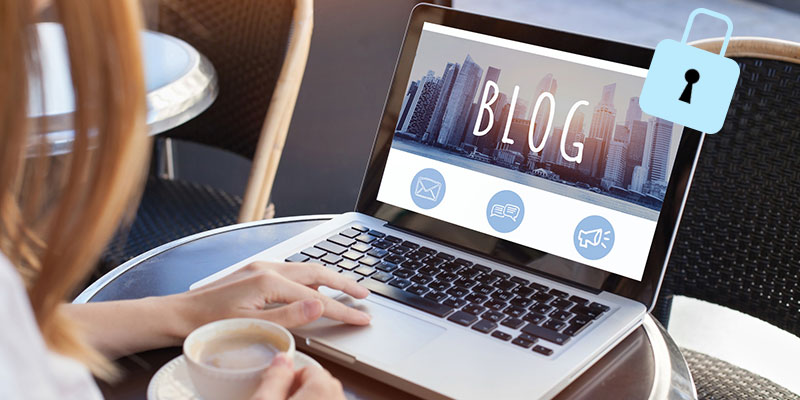
Each day, professional hackers and malicious plagiarists crowd the internet to search for Website security loopholes on active websites. When they see your blog is vulnerable, they might do anything on that site for example, redirecting your traffic to their website by installing malware on your site. Here are the blog security tips which can be helpful to secure your WordPress blog !
Irrespective of the tons of hacking cases that occur online daily, only a few people show concern about blog security. Likewise, you should not think your WordPress website is free from such attacks.
Also, hacking should not be your only concern if you run a blog/website. Instead, content theft maybe your major issue, if you are blogging, as your trademark of quality, is uniqueness. Search engines like Google make algorithms to recognize the origin of specific content. But, you get bored when you realize your content was copied and pasted in many other blogs.
One of the most popular CMS to set up blogs on the internet is WordPress. For this reason, it draws great attention of hackers. Luckily, you can take various measures to avoid such WordPress security threats.
Best Blog security tips to improve WordPress blog security
1. Disable hotlinking
If someone copies your content in a particular article, he/she is likely to copy images in that article. This is known as hotlinking, which is the direct copying of images from another website. Assuming one does so and then publish your article on their blog, then the image URLs points to your server. As a result, your hosting gets extra load, which reduces the performance of your blog. However, you can avoid hotlinking using the Cloudflare solution. Cloudflare is a perfect content delivery network. The main work of this tool is to enhance the loading time of your web pages.
To do so, this tool caches the content, gather information on the location of your visitors, and then send the cached data from your local server. Besides that, this tool is available for free, making it a must-have for bloggers. But, in this case, you need Cloudflare hotlink protection. To stop this issue, go to Security Settings >> Hotlink protection >> and enable the “ON” button.
2. Back up your blog automatically

Recovering your website from its deadliest hacks is easier if you perform regular WordPress Website backup. Indeed, a click is enough to restore your complete website.
Also, you should create a backup before implementing any major changes on your website. It is one of the proven blog security tips which can be helpful to secure your blog. For example, installation of a new plugin, or upgrading your WordPress to the latest version. Use the Better WP Security plugin to plan backups and improve the Website security.
3. Secure your login
Maybe you have realized that the default username on your WordPress blog is your admin. All hackers may know this. Thus, ensure you have changed the default username. Moreover, apply Captcha for your user login, to protect yourself from brute force attacks. It is one of the best blog security tips which can be helpful to secure your blog.
To establish Captcha, use any of the best WordPress security plugins. A Captcha plugin is also useful in blocking spam.
4. Install Wordfence and Limit Login Attempts plugins
These Website security plugins are powerful and block hackers from accessing your blog.
- limit login attempts: This plugin helps you to block threats form your WordPress login page. It empowers you to restrict the number of times which someone can unsuccesfully try to access your WP admin dashboard. If you need a team to manage WordPress themes & Plugins, then you can hire WP Experts.
- wordfence: This is a powerful security plugin that offers you with unique features. These include finding outdated plugins, scanning comments for phishing URLs and malware. And, scanning themes and plugins versus your WordPress repository versions for recent changes. You can get this great plugin for free.
Helpbot is a WordPress support agency which provides proactive WordPress website maintenance and professional WordPress support services to website owners belonging to different business niches. Get 24×7 WordPress support for fixing common WordPress errors.
5. Add links to protect against copy/paste
Stealing web content does not need any complex tools. Instead, it is an easier process of copying and pasting an article in another blog. Furthermore, formatting is not a concern as it gets copied too. But, you can prevent this using Tynt service. This service does not disable content copying. Instead, it adds an attribution URL to your website whenever someone copies content on your website. The outcome appears as content + read more at www.yourblog.com.
Although you might think the content thieves will solve by deleting that link, most of them do not notice the link. Yes, most of these thieves copy, paste and publish the content. Once you install Tynt, you will get stats on the exact number of copy commands which happened on your website, and the most copied blog posts. Also, this tool assists you in knowing the number of links you have made from the attribution links.
6. Install a firewall
To secure your website from hacking and other security trials, you must install the Open Source Excellence Firewall (OSE Firewall). This firewall comes with a built-in scanner that scans your blog for any dangerous codes. Moreover, it has an anti-spam feature which ensures your blog is free from spam.
7. Install only trusted plugins
It is easier for hackers to access your website using your installed Website plugins. You create chances for a hacker to access your WordPress core files when you install a plugin. Another one from blog security tips is to take extra care when installing any plugin on your blog.
Here are four main things to consider before installing any plugin:
Make sure the plugin Instead in the plugins directory on WordPress.org
In case the plugin is not in this directory, then it is either premium or illegal. But, go ahead and install it if it has a download option in the directory.
Look at the rating
You should check the star rating which users have assigned that plugin, and the distribution of votes. If 5-star ratings are less than 1-start ratings, then this plugin might have some security concerns.
number of downloads
Look out for a famous plugin. Check the number of downloads for each plugin to know if it popular. Nonetheless, bad plugins rarely make thousands of downloads as moderators delete them within a short time.
find out at third-party reviews
As stated earlier, premium plugins are not listed in the WordPress plugins directory. As a result, it is difficult for you to determine their legitimacy. Thus, you should check out the reviews of those who ever used the plugin. To know if a premium plugin is legit and safe for use, you should visit the CodeCanyon directory, as it features them.
8. Add password authentication to your WP-admin folder

One of the best ways to keep hackers away from your website is making it harder for them to access it via your login page. To do so, ensure you have added password protection on your “WP-admin” folder. This ensures that whoever access this folder must enter the correct username and password, besides the user login. The easiest means to add password verification is via the CPanel. All you need is to log into your CPanel and choose the “Password Protect directories” option.
9. Create your own Google authorship
Any time there is duplicate content, Google and other search engines might decide the content that should get lower ranking by searching for the content that got published earlier. But, that is not enough, particularly where the blog of the person who stole your content has higher rankings. In this case, the stolen content may continue getting more link juice.
So, you should apply Google authorship at this point. If your authorship gets validated, then the chances of your content getting ranked lower than similar copied and published content is lower.
Here is the process on how to set up Google authorship:
- First, sign up for a Google+ account.
- Go to “Contributor to” in your profile settings.
- Add your blog link here.
- Next, install the Yoast SEO plugin.
- After that, navigate to users >> your profile >> contact info.
- Here, add the profile link of your Google+ account.
10. Do not share your WordPress version to the public
WordPress websites publish the version number, making it easier for visitors to determine if you using an outdated WordPress version. So, sharing your WordPress website version number makes it vulnerable to attacks and other security attacks. Although you can remove your WordPress version from your web page, you should implement some extra change. You can do by going to your WordPress installation directory and remove the readme.html file from your directory.
This file tells your WordPress website version to the entire world. Furthermore, some WordPress themes have login links for easier access to a login page. You should not show your login page in a way that allows even hackers to access it. For this reason, you should either remove or change your theme if it contains a login link.
Summary
Are you determined to secure your WordPress website from unauthorized access and keep content thieves far from your work? You can use the above-mentioned blog security tips for securing your WordPress blog. Nonetheless, it is good to note that there is no guaranteed tool to stop content theft. But you can prevent it by following these blog security tips! Get to know about a complete guide on security loopholes and ways to rectify them!
Use our comments section if you have any questions, suggestions, or comments.





